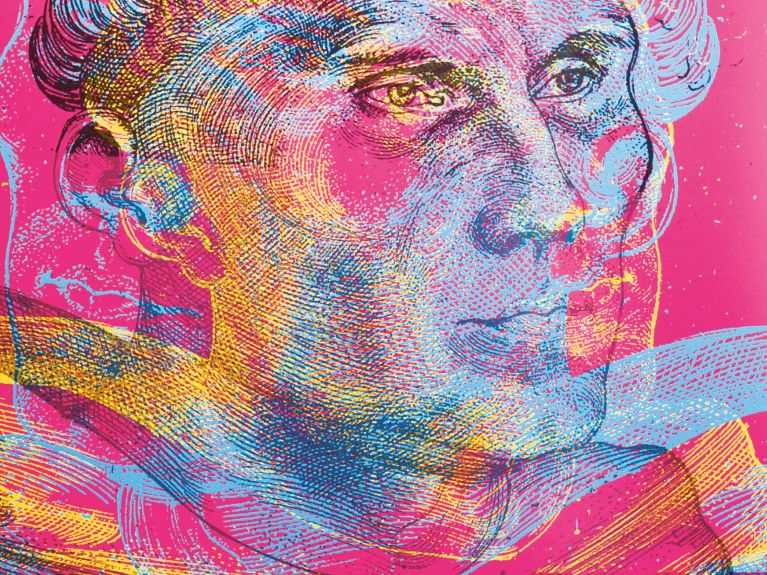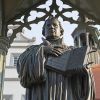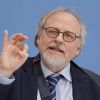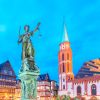Reformation Day: Martin Luther, the Reformer
How Martin Luther and the Reformation have continued to influence German society until the present.

Take, for example, the story about the apple tree. “Even if I knew that tomorrow the world would go to pieces, I would still plant my apple tree,” Martin Luther is supposed to have said. This is just one of many legends about the Reformer that merrily continue to be passed on despite a complete lack of references. Ultimately it probably doesn’t matter whether the nature-loving Luther actually used these words or not. What is important is that they show how much he has influenced German society. Researchers believe that this saying was only attributed to the Reformer after the Second World War. When people lived between optimism and desperation they felt reminded of Luther. Five hundred years after the publication of his Ninety-Five Theses it is again time to take a closer look and show how strongly his life and work still influence us today.
Who was Martin Luther?
Martin Luther was born in Eisleben in 1483. He entered St Augustine’s Monastery in Erfurt in 1505. Luther was a devout Christian and an erudite theologian. However, he had increasing doubts about the teachings of the Church. Why could people buy spiritual salvation for money? Why did the word of the Pope count more than that of the Bible? In 1517, after becoming a professor of theology, Luther published his Ninety-Five Theses criticising the Church. At the beginning of 1521 he was expelled from the Church and supposed to revoke his teachings before Emperor Charles V at an Imperial Diet in Worms. Luther did not submit. By then – thanks to the invention of printing with movable type – he was already a best-selling author. He hid in Wartburg Castle and translated the New Testament into German. The people and many princes accepted his teaching. A special point about Luther was his attitude towards the Jews: at first he hoped to be able to convert them, later he became a virulent anti-Semite. In 1525, Luther married the nun Katharina von Bora. He died in Eisleben in 1546.
What was the Reformation?
The Reformation was a movement to revitalise the Church that affected almost the whole of Europe and divided Western Christianity into Protestants and Catholics. It represented a fresh start in a variety of ways. Luther and his ideas became dominant in Germany, Scandinavia and the Baltic region. In other countries, reformers like Johannes Calvin (France/Switzerland) and Ulrich Zwingli (Switzerland) came to the fore, and their ideas gave rise to the Reformed tradition. A national Protestant Church developed in England with the advent of Anglicanism. All Protestants shared a rejection of the Papal Church at that time, a strong orientation towards the Bible and a new concept of “grace”: the human being achieves salvation through the grace of God, not through good works. Martin Luther’s publication of the Ninety-Five Theses in 1517 was a milestone in the Reformation. In them, he primarily attacked the Church’s trade in letters of indulgence. Luther demanded that instead of acquiring absolution for money, believers should show inner repentance. In the following period the conflict escalated between the old Church and the supporters of renewal. Eventually new denominations split away from Catholicism – and from then on a denominational boundary divided Europe. This division led to the Thirty Years’ War from 1618 to 1648 and established two separate marriage circles, because marriages between members of the different denominations were rare. Some historians and sociologists believe that the Protestant mentality encouraged modern economic development and that as a result Catholic Europe declined.
How is Protestantism different from Catholicism?
Protestants reject the traditional hierarchical Church. They do not only criticise the Catholic order with the Pope at its head. Protestants believe in the “priesthood of all believers”, which means that everyone who is baptised has a direct connection with God and does not need the intercession of a priest. Catholicism came to partially accept this teaching in the 20th century. The highest authority for Protestants is the word of Jesus, as found in the Bible, while in Catholicism for a long time the Pope and Councils remained more important. Another difference is the number of sacraments. In the Catholic Church there are seven – Baptism, Confirmation, Eucharist (Holy Communion), Sacrament of Penance, Anointing of the Sick, Holy Orders and Marriage – while the Protestants have essentially reduced them to only Baptism and Eucharist. The significance of Communion differs too: Catholics believe bread and wine are transformed into the body and blood of Christ, while Lutherans believe Jesus is only present. For Calvinists and believers in the Reformed tradition Communion is only a commemoration of Christ’s sacrificial death.
How did the Reformation change Germany?
The Reformation has left a mark on Germany in two respects: on the one hand, the country was divided into two denominational camps, while in many other countries one denomination achieved a clear majority. This division between Protestants and Catholics has determined German history for a long time. Second, Protestantism had considerable consequences as a result of its ideas and actions. For example, Luther’s translation of the Bible contributed to a common standard language. At the same time it encouraged a culture of reading in Protestant regions. Because modern education was above all a matter of reading, Protestant regions had an educational advantage that was felt into the 20th century. The situation was rather different in the fine arts. The Catholic religion was an image-based culture, while pictures were less significant in Lutheran churches and disappeared completely from the Reformed tradition. When it came to music, Luther sent out strong signals because he wrote church hymns himself and great Protestant chorales were composed. A rather complicated issue is the connection between Protestantism and (political) freedom. The most frequently printed work in 16th century Germany was Luther’s On the Freedom of a Christian. It focuses above all on religious freedom. When German peasants rose up to fight for political freedom and invoked Luther, he strongly condemned their actions. Nevertheless, there are lines leading from Luther and the other reformers to modern political freedom. Taking the Bible as the supreme authority enabled them to attack the papacy; it also meant secular rulers could be challenged on the same basis. On the other hand, the Lutheran Church developed in close association with territorial rulers so that occasionally Luther was linked with a supposed German mentality of subservience.
What effect did the Reformation have on the world?
Initially, the Reformation made a mark on northern Europe, while the south, as well as Poland and Lithuania, remained largely Catholic. Protestantism was carried out into the world from Europe. Today roughly 400 million people worldwide belong to Protestant Churches. The United States was very strongly influenced by different Evangelical movement such as Baptists, Adventists and Quakers. That has affected not only everyday social life, but also business. Radical Protestants like the Evangelicals promote an extremely conservative policy there today. Evangelical Christians are now also active in the predominantly Catholic countries of South America. Many countries in sub-Saharan Africa have large Protestant populations whose beginnings go back to the European colonial movement. This applies to the south of the continent with South Africa and Zimbabwe, the east with Tanzania and Uganda, as well as the west with Ghana. In Asia, there are also a comparatively high number of Protestants in South Korea.


